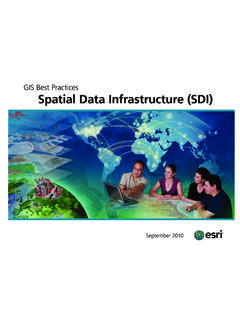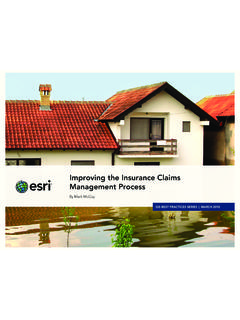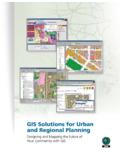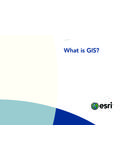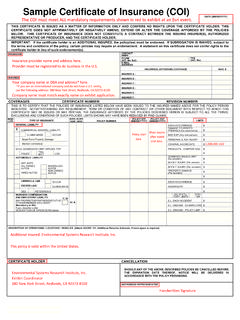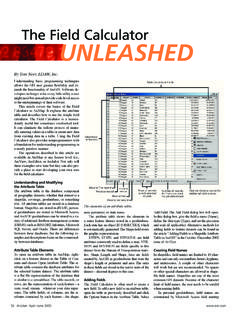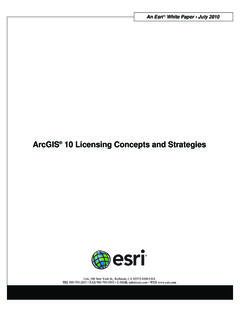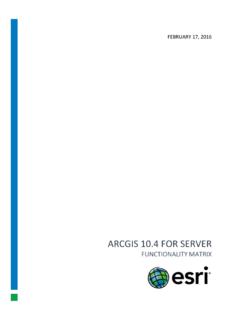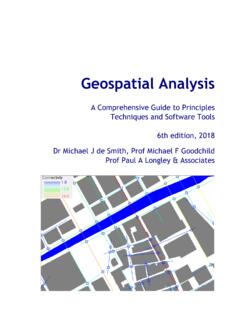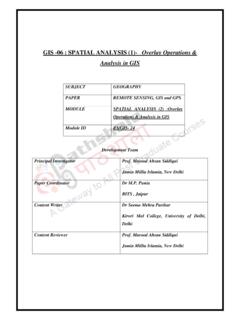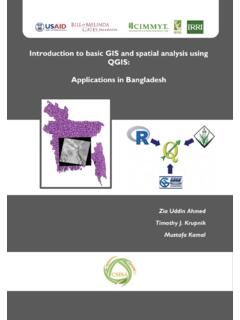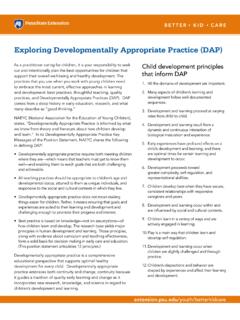Transcription of The Language of Spatial Analysis - Esri
1 The Language ofspatial Analysis Foreword How to use this book Chapter 1 An introduction to Spatial Analysis Chapter 2 The vocabulary of Spatial analysisUnderstanding whereMeasuring size, shape, and distributionDetermining how places are relatedFinding the best locations and pathsDetecting and quantifying patternsMaking predictions Chapter 3 The seven steps to successful Spatial Analysis Chapter 4 The benefits of Spatial Analysis Case study Bringing it all together to solve the problem Reference A quick guide to Spatial Analysis Additional resourcesCONTENTSW atching the GIS industry grow for more than 25 years, I have seen innovation in the problems we solve, the people we can reach through technology, the stories we tell, and the decisions that help make our organizations and the world more successful.
2 However, what has not changed is our longstanding goal to better understand our world through Spatial Analysis . Traveling the world I have met people from many diverse cultures who work in a wide range of industries. However, as I listen to their mission and challenges, there is a common pattern: we all speak the same Language it is the Language of Spatial Language consists of a core set of questions that we ask, a taxonomy that organizes and expands our understanding, and the fundamental steps to Spatial Analysis that embody how we solve Spatial encourage each of you to learn and communicate to the world the power of Spatial Analysis . Learn the definition, learn the vocabulary and the process, and most important, be able to speak this Language to the world.
3 The greatest potential for change and success occurs when we all understand and speak the same Language the Language of Spatial Analysis . Christopher Cappelli, EsriFOREWORDThe Language of Spatial Analysis is designed as an interactive workbook that allows you to create and add your own sample questions of Spatial Analysis (from your industry or domain expertise), which can add to your vocabulary when explaining Spatial Analysis to others. To take advantage of this capability, make sure to read the book with the latest version of Adobe Reader and add your own you are viewing on a desktop computer or laptop, you will need to download Adobe Reader XI at Using this software you can read your document and answer questions in the spaces provided.
4 Record your answers after each section by clicking the Comment button . Then click the Add Text Comment tool and fill in your responses. Save, e-mail, or print the personalized document for future reference. If you are viewing this on a tablet or smartphone, you will need to download the free Adobe Reader App at for Apple devices or for Android devices. Using these apps you can read the document and answer questions in the spaces provided. Record your answers to the questions by tapping the Comment button on the toolbar and filling in your responses. Save, e-mail, or print the personalized document for future TO USE THIS BOOKAn introduction to Spatial analysisWhen did you first learn how to perform Spatial Analysis ? Perhaps you recall your first job or the first time you used a geographic information system (GIS) in college.
5 Or maybe it was the day you joined the Army, and you were given a topographic map. However, in reality, you learned about Spatial Analysis at a much earlier age. For most of you, the beginning of your Spatial Analysis education was around age two and the time you started walking. The cognitive development of geography and subsequently Spatial Analysis actually began as soon as you became aware of your geographic surroundings and you started to become often than not, the first step in Spatial Analysis is understanding where. At two years old, you became aware of where you were in the bedroom or in the kitchen. Your skills then started to expand into the second development phase navigation. How do you go from one room to the next, and then how do you go from home to school?
6 You did not need to take a class in Spatial Analysis , but it was becoming very much ingrained in your everyday third step in cognitive development is understanding Spatial relationships and patterns looking at the world around you, asking questions, and attempting to make sense of your surroundings and how they affect your actions. Each of us has gone through these stages in our understanding of Spatial Analysis and in cognitive development. Most people are very well versed in understanding where they are, many are good at navigation, but it is the last phase of development that opens the way to solving the harder challenges of the world this last phase is also the most expansive in terms of opportunities and benefits. It is not just where you are, or how you get there, that most people are trying to figure out usually it is a much bigger question or a much larger challenge that needs to be 1 Welcome to the world of Spatial Analysis .
7 Spatial Analysis how we understand our world mapping where things are, how they relate, what it all means, and what actions to are many definitions of Spatial Analysis . However, the best place to start is with a practical definition that everyone can understand. Spatial Analysis is how we understand our world mapping where things are, how they relate, what it all means, and what actions to take. Whether you are talking about the small child standing in the kitchen looking around wondering where to go next or the GIS professional analyzing the implications of a new building on the landscape, the same practical definition we look at a map, we inherently start turning that map into information by finding patterns, assessing trends, or making decisions.
8 This is Spatial Analysis , and it s what our minds do naturally whenever we look at a map. Spatial Analysis is a diverse and comprehensive capability that includes the simple visual Analysis of maps and imagery, computational Analysis of geographic patterns, finding optimum routes, site selection, and advanced predictive modeling. This process happens every day in the human brain. However over the last four decades, our ability to solve complex Spatial problems has grown exponentially with technologies that include global positioning systems, real-time sensors, navigation systems, and most important, you grow past childhood, you discover that detecting patterns and relationships isn t always obvious by looking at a map. Often, there s too much data to sift through and present coherently on a map, and the way data is displayed on the map can change the patterns you see.
9 GIS provides the Spatial Analysis tools to help us better discover, quantify, and understand geographic phenomena and determine what actions to Language of Spatial analysisNow that we have a practical definition of Spatial Analysis , how do we think about Spatial problems, and how can we explain these concepts to others? Before answering these two questions, try the following challenge:Close your eyes and think about something anything for one minute. And try to think about it without using words without using a people will find that their thoughts are comprised of unspoken words. The truth is, even the simplest thoughts are difficult without Language , without the vocabulary that you ve been building up your entire life. Language is the key not only to communication and speech, but also to thinking and reasoning.
10 Now apply this idea to Spatial Analysis . How can we think spatially, and how can we explain the concepts of Spatial Analysis to others? The answer is with a vocabulary and with a Language of Spatial Language of Spatial analysisWith an endless list of Spatial questions that need to be answered, it is helpful to classify and group these questions in order to establish a common Language . The resulting classification, or taxonomy, provides the structure that can help us better learn, understand, and communicate to the world how Spatial Analysis is a critical part of problem taxonomy of Spatial Analysis includes six high-level categories that classify and group related analytical six categories of Spatial Analysis Understanding where Measuring size, shape, and distribution Determining how places are related Finding the best locations and paths Detecting and quantifying patterns Making predictionsEach category reflects a set of related question types.
